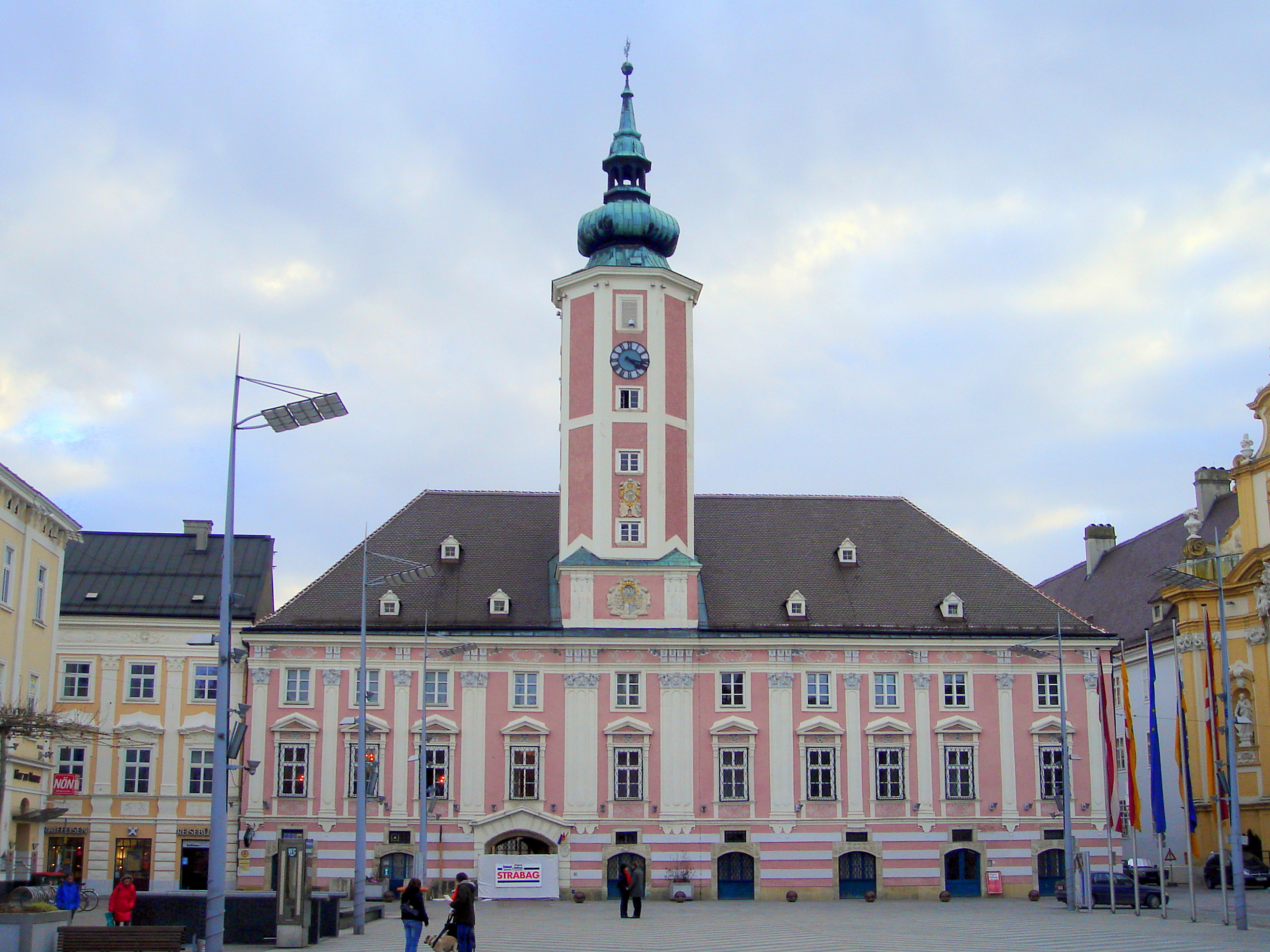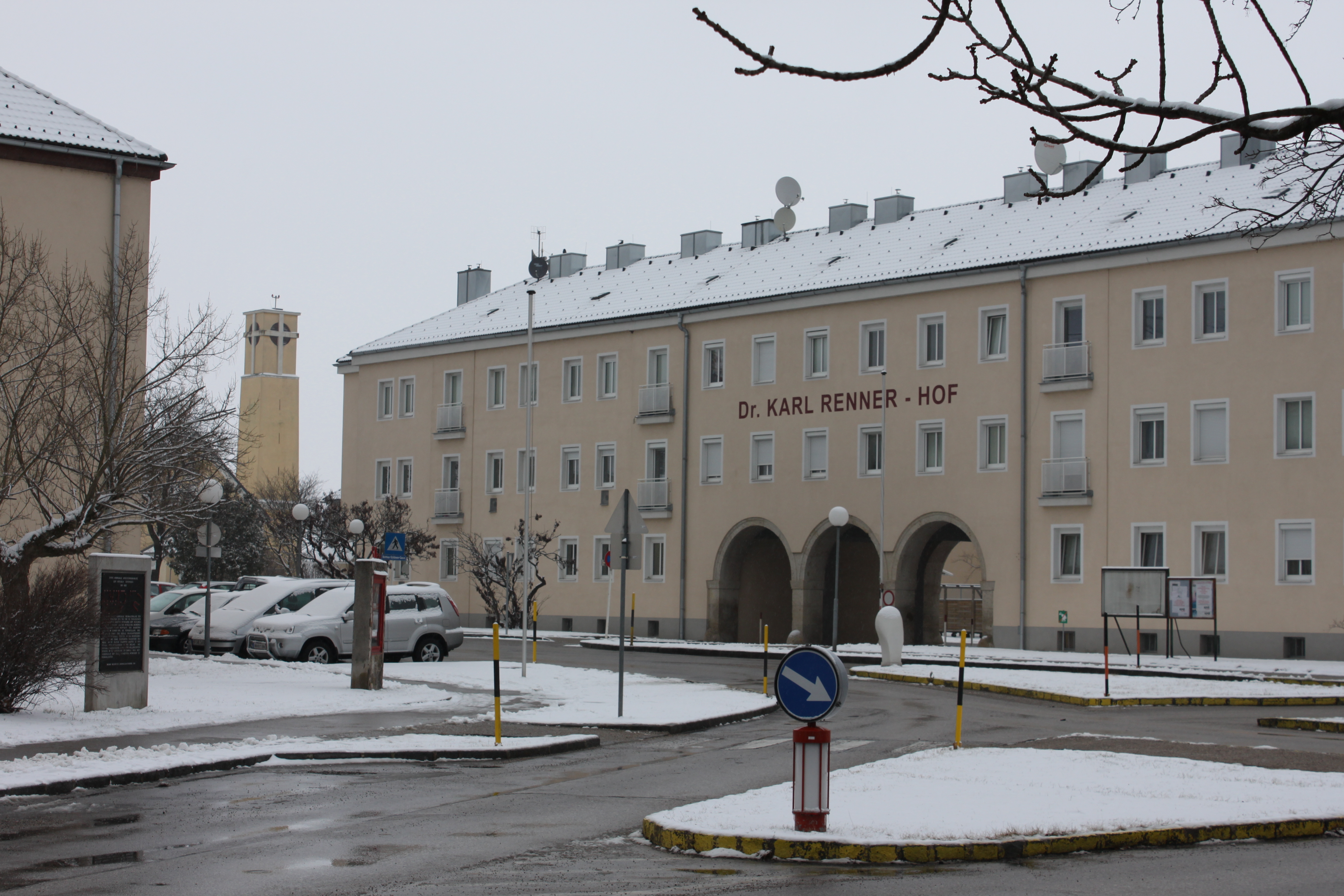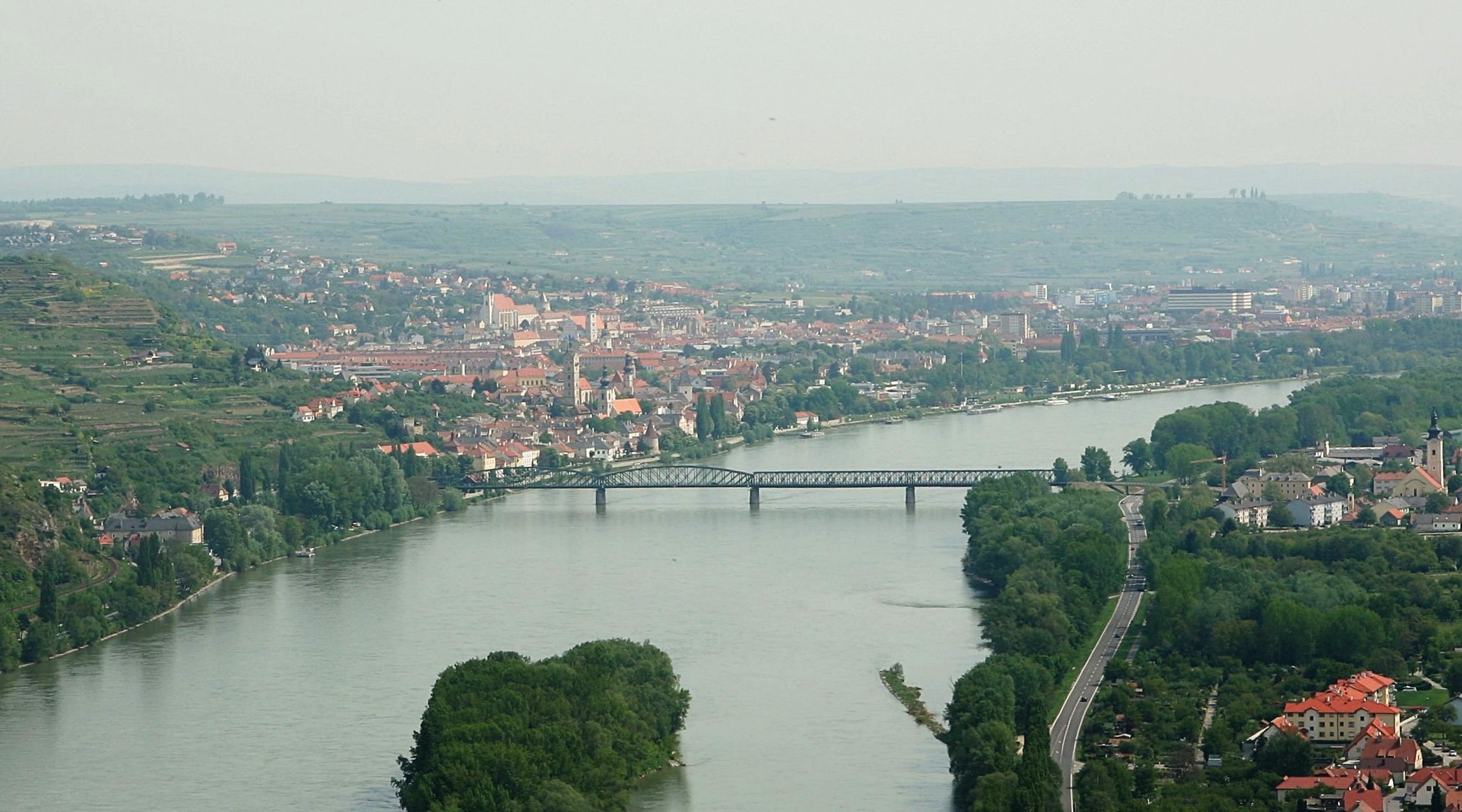|
Niederösterreich
Lower Austria ( , , abbreviated LA or NÖ) is one of the nine states of Austria, located in the northeastern corner of the country. Major cities are Amstetten, Krems an der Donau, Wiener Neustadt and Sankt Pölten, which has been the capital of Lower Austria since 1986, replacing Vienna, which became a separate state in 1921. With a land area of and a population of 1.7 million people, Lower Austria is the largest and second-most-populous state in Austria (after Vienna). Geography With a land area of situated east of Upper Austria, Lower Austria is the country's largest state. Lower Austria derives its name from its downriver location on the river Enns, which flows from the west to the east. Lower Austria has an international border, long, with the Czech Republic (South Bohemia and South Moravia) and Slovakia (Bratislava and Trnava Regions). The state has the second-longest external border of all Austrian states. It also borders the other Austrian states of Upper Austria, S ... [...More Info...] [...Related Items...] OR: [Wikipedia] [Google] [Baidu] [Amazon] |
Landtag Of Lower Austria
The Landtag of Lower Austria is the state parliament of the Austrian state of Lower Austria. It exercises the state legislation (legislature). The seat of the Landtag is in St. Pölten in the Landhausviertel. The Lower Austrian Parliament is composed of 56 members of parliament. The term of office is five years. Elections are held in accordance with the Lower Austrian Landtag election regulations of 1992. 21 constituencies in Lower Austria correspond to the political districts. The statutory cities belong to the district of the same name or the surrounding district. The number of deputies corresponds to the number of inhabitants. To be eligible to stand as a candidate, a candidate must be 18 years of age (on election day) and have at least 50 declarations of consent. They are nominated by a political party. In order to enter the state parliament, one party must reach the four percent hurdle or obtain a mandate in a constituency. The most recent elections to the Landtag of Lower A ... [...More Info...] [...Related Items...] OR: [Wikipedia] [Google] [Baidu] [Amazon] |
Sankt Pölten
Sankt Pölten (; Central Bavarian: ''St. Pödn''), mostly abbreviated to the official name St. Pölten, is the capital and largest city of the States of Austria, State of Lower Austria in northeast Austria, with 55,538 inhabitants as of 1 January 2020. St. Pölten is a city with its own statute (or ''Statutarstadt'') and therefore it is both a municipality and a district in the ''Mostviertel''. Due to its cultural status, it has recently enjoyed an increase of visitors passing through Sankt Pölten on their way to Vienna. Geography The city lies on the Traisen (river), Traisen river and is located north of the Alps and south of the Wachau. It is part of the ''Mostviertel'', the southwest region of Lower Austria. Subdistricts St Pölten is divided into the following subdistricts: Altmannsdorf, Dörfl at Ochsenburg, Eggendorf, Ganzendorf, Hafing, Harland, Hart, Kreisberg, Matzersdorf, Mühlgang, Nadelbach, Oberradlberg, Oberwagram, Oberzwischenbrunn, Ochsenburg, Pengersdorf, Pott ... [...More Info...] [...Related Items...] OR: [Wikipedia] [Google] [Baidu] [Amazon] |
Vienna
Vienna ( ; ; ) is the capital city, capital, List of largest cities in Austria, most populous city, and one of Federal states of Austria, nine federal states of Austria. It is Austria's primate city, with just over two million inhabitants. Its larger metropolitan area has a population of nearly 2.9 million, representing nearly one-third of the country's population. Vienna is the Culture of Austria, cultural, Economy of Austria, economic, and Politics of Austria, political center of the country, the List of cities in the European Union by population within city limits, fifth-largest city by population in the European Union, and the most-populous of the List of cities and towns on the river Danube, cities on the river Danube. The city lies on the eastern edge of the Vienna Woods (''Wienerwald''), the northeasternmost foothills of the Alps, that separate Vienna from the more western parts of Austria, at the transition to the Pannonian Basin. It sits on the Danube, and is ... [...More Info...] [...Related Items...] OR: [Wikipedia] [Google] [Baidu] [Amazon] |
Udo Landbauer
Udo Landbauer (born 12 April 1986 in Neunkirchen, Austria) is an Austrian far-right politician from the FPÖ. From 2011 to 2018 he was head of the FPÖ Youth Ring, from 2010 to 2018 Landbauer was a municipal politician in Wiener Neustadt and from 2013 to 2018 he was a member of the provincial parliament (Landtag) of Lower Austria. He was the leading candidate of the FPÖ in the 2018 Lower Austrian provincial parliament elections. As a result of the affair surrounding the ''Germania zu Wiener Neustadt'' fraternity, he resigned from all political functions on 1 February 2018 and suspended his FPÖ party membership. On 20. September he returned as member of the Freedom Party of Austria to the Lower Austrian provincial parliament. On the same day he was elected as the head of the FPÖ of Lower Austria. Biography Udo Landbauer was born as the son of an Austrian father and an Iranian mother. His father and brother are also active in the FPÖ. He attended grammar school at the Theres ... [...More Info...] [...Related Items...] OR: [Wikipedia] [Google] [Baidu] [Amazon] |
Krems An Der Donau
Krems an der Donau (, ) is a city in Lower Austria, Austria. With a population of 24,821, it is the 20th-largest city of Austria and fifth-largest of Lower Austria. It is approximately west of Vienna. Krems is a city with its own statute (or ''Statutory city (Austria), Statutarstadt''), and therefore it is both a municipality and a district. Geography Krems is located at the confluence of the Krems (Lower Austria), Krems and Danube Rivers at the eastern end of Wachau valley, in the southern Waldviertel. Krems borders the following municipalities: Stratzing, Langenlois, Rohrendorf bei Krems, Gedersdorf, Traismauer, Nußdorf ob der Traisen, Paudorf, Furth bei Göttweig, Mautern an der Donau, Dürnstein, and Senftenberg. History Krems was first mentioned in 995 in a certificate of Otto III, but settlement was apparent even before then. For example, a child's grave, over 27,000 years old, was found here. This is the oldest grave found in Austria. During the 11th and 12th cen ... [...More Info...] [...Related Items...] OR: [Wikipedia] [Google] [Baidu] [Amazon] |
Wiener Neustadt
Wiener Neustadt (; Lower_Austria.html" ;"title=".e. Lower Austria">.e. Lower Austria , ) is a city located south of Vienna, in the state of Lower Austria, in northeast Austria. It is a self-governed city and the seat of the district administration of Wiener Neustadt-Land District. The city is the site of one of the world's oldest military academies, the Theresian Military Academy, which was established by Empress Maria Theresa of Austria in 1751 to train officers for the Austrian army. History The area once belonged to the County of Pitten, which had been inherited by Margrave Ottokar III of Styria in 1158. After the dynasty of the Otakars became extinct with the death of his son Ottokar IV, the Duchy of Styria passed to the Austrian House of Babenberg according to the Georgenberg Pact. Duke Leopold V of Austria established the town called Neustadt in 1194 and financed the construction of a fortress close to the Hungarian border with the ransom paid for the English ... [...More Info...] [...Related Items...] OR: [Wikipedia] [Google] [Baidu] [Amazon] |
Wachau (3)
The Wachau () is an Austrian valley formed by the Danube River. It is one of the most prominent tourist destinations of Lower Austria, located between the towns of Melk and Krems that attracts epicureans for its high-quality wines. It is in length and has been settled since prehistoric times. Among the tourist attractions is Dürnstein Castle, where King Richard I of England was held captive by Leopold V, Duke of Austria. The architectural elegance of its monasteries (Melk Abbey and Göttweig Abbey), castles and ruins combined with the urban architecture of its towns and villages, and the cultivation of vines as an important agricultural produce are the dominant features of the valley. The Wachau was inscribed as "Wachau Cultural Landscape" in the UNESCO List of World Heritage Sites in recognition of its architectural and agricultural history, in December 2000. History Ancient history Even before the Neolithic period brought in changes in the natural environment of the va ... [...More Info...] [...Related Items...] OR: [Wikipedia] [Google] [Baidu] [Amazon] |
Upper Austria
Upper Austria ( ; ; ) is one of the nine States of Austria, states of Austria. Its capital is Linz. Upper Austria borders Germany and the Czech Republic, as well as the other Austrian states of Lower Austria, Styria, and Salzburg (state), Salzburg. With an area of and 1.49 million inhabitants, Upper Austria is the fourth-largest Austrian state by land area and the third-largest by population. History Origins For a long period of the Middle Ages, much of what would become Upper Austria constituted :de:Traungau, Traungau, a region of the Duchy of Bavaria. In the mid-13th century, it became known as the Principality above the Enns River ('), this name being first recorded in 1264. (At the time, the term "Upper Austria" also included German Tyrol, Tyrol and various scattered Habsburg possessions in southern Germany.) Early modern era In 1490, the area was given a measure of independence within the Holy Roman Empire, with the status of a principality. By 1550, there was a Protestanti ... [...More Info...] [...Related Items...] OR: [Wikipedia] [Google] [Baidu] [Amazon] |
Capital City
A capital city, or just capital, is the municipality holding primary status in a country, state (polity), state, province, department (administrative division), department, or other administrative division, subnational division, usually as its Seat of government, seat of the government. A capital is typically a city that physically encompasses the government's offices and meeting places; the status as capital is often designated by its law or constitution. In some jurisdictions, including several countries, different branches of government are in different settlements, sometimes meaning multiple official capitals. In some cases, a distinction is made between the official (constitutional) capital and the seat of government, which is in list of countries with multiple capitals, another place. English language, English-language media often use the name of the capital metonymy, metonymically to refer to the government sitting there. Thus, "London-Washington relations" is widely unde ... [...More Info...] [...Related Items...] OR: [Wikipedia] [Google] [Baidu] [Amazon] |
States Of Austria
Austria is a federal republic consisting of nine federal states. The European Commission calls them provinces. Austrian federal states can pass laws that stay within the limits of the constitution, and each federal state has representatives in the main Austrian parliament. Geography The majority of the land area in the federal states of Upper Austria, Lower Austria, Vienna, and Burgenland is situated in the Danube valley and thus consists almost completely of accessible and easily arable terrain. Austria's most densely populated federal state is Vienna, the heart of what is Austria's only metropolitan area. Lower Austria ranks only fourth in population density even though it contains Vienna's suburbs; this is due to large areas of land being predominantly agricultural. The alpine federal state Tyrol, the less alpine but geographically more remote federal state Carinthia, and the non-alpine but near-exclusively agricultural federal state Burgenland are Austria's least densely ... [...More Info...] [...Related Items...] OR: [Wikipedia] [Google] [Baidu] [Amazon] |
Enns (river)
The Enns () is a southern tributary of the river Danube in Austria, joining northward at the city of Enns. It forms much of the border between the states of Lower Austria and Upper Austria. The Enns spans , in a flat-J-shape. It flows from its source near the village Flachau, generally eastward through Radstadt, Schladming, and Liezen, then turns north near Hieflau, to flow past Weyer and Ternberg through Steyr, and further north to the Danube at Enns (''see map in References''). "Karte-Enns" (river map in German), RadTouren.at (Austria), May 2009, webpage: (236kb). Name It was known in Latin as ''Anisus'' or ''Anasus'', of uncertain origin; Anreiter et al. tried to link it to an Indo-European *''on''- and the hydronymic suffix *''-is-''. Later sources call it ''Ensa'' or ''Enisa''. Others have linked it to Upper Danubian Vasconic *''an'', "water." Another possible link is Greek ᾰ̓νῠστός (''anystos'', "useful"). The West Slavic languages have different name ... [...More Info...] [...Related Items...] OR: [Wikipedia] [Google] [Baidu] [Amazon] |
Czech Republic
The Czech Republic, also known as Czechia, and historically known as Bohemia, is a landlocked country in Central Europe. The country is bordered by Austria to the south, Germany to the west, Poland to the northeast, and Slovakia to the southeast. The Czech Republic has a hilly landscape that covers an area of with a mostly temperate Humid continental climate, continental and oceanic climate. The capital and largest city is Prague; other major cities and urban areas include Brno, Ostrava, Plzeň and Liberec. The Duchy of Bohemia was founded in the late 9th century under Great Moravia. It was formally recognized as an Imperial Estate of the Holy Roman Empire in 1002 and became Kingdom of Bohemia, a kingdom in 1198. Following the Battle of Mohács in 1526, all of the Lands of the Bohemian Crown were gradually integrated into the Habsburg monarchy. Nearly a hundred years later, the Protestantism, Protestant Bohemian Revolt led to the Thirty Years' War. After the Battle of White ... [...More Info...] [...Related Items...] OR: [Wikipedia] [Google] [Baidu] [Amazon] |




